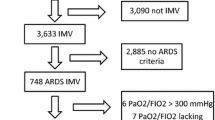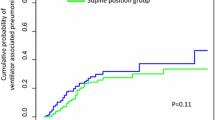Abstract
Objective
To investigate the prognostic factors in acute respiratory distress syndrome (ARDS) patients focusing on the use of prone positioning (PP).
Design and setting
Retrospective study conducted in an intensive care unit of a university hospital.
Patients
All consecutive mechanically ventilated ARDS patients surviving on day 7 after the diagnosis of ARDS.
Methods
The study included all ARDS patients who survived more than 7 days after ARDS diagnosis between January 1995 and December 2002. Demographic and respiratory variables were collected on day 1, and the management of ARDS was analyzed during the first 7 days (n=125). We performed a univariate analysis and a stepwise logistic regression analysis comparing survivors and nonsurvivors on day 28 and at 2 and 6 months.
Results
Mortality rates on day 28 and at 2 and 6 months were 21.6%, 32%, and 44% respectively. A SAPS II score less than 49, McCabe score, and the use of PP introduced in the first 7 days of ARDS management appeared to be independently correlated with a decrease in mortality.
Conclusions
The SAPS II score, the McCabe score, and use of PP are independently correlated with the outcome in ARDS patients.
Similar content being viewed by others
References
Ashbaugh DG, Bigelow DB, Petty TL, Levine BE (1967) Acute respiratory distress in adults. Lancet II:319–323
Krafft P, Fridrich P, Pernerstorfer T, Fitzgerald RD, Koc D, Schneider B, Hammerle AF, Steltzer H (1996) The acute respiratory distress syndrome: definitions, severity and clinical outcome. An analysis of 101 clinical investigations. Intensive Care Med 22:519–529
Steltzer H, Krafft P (1999) Improved outcome of ARDS patients: are we really performing better? Intensive Care Med 25:887–889
Esteban A, Alia I, Gordo F, de Pablo R, Suarez J, Gonzalez G, Blanco J (2000) Prospective randomized trial comparing pressure-controlled ventilation and volume-controlled ventilation in ARDS. For the Spanish Lung Failure Collaborative Group. Chest 117:1690–1696
Ferring M, Vincent JL (1997) Is outcome from ARDS related to the severity of respiratory failure? Eur Respir J 10:1297–1300
Luhr OR, Karlsson M, Thorsteinsson A, Rylander C, Frostell CG (2000) The impact of respiratory variables on mortality in non-ARDS and ARDS patients requiring mechanical ventilation. Intensive Care Med 26:508–517
Monchi M, Bellenfant F, Cariou A, Joly LM, Thebert D, Laurent I, Dhainaut JF, Brunet F (1998) Early predictive factors of survival in the acute respiratory distress syndrome. A multivariate analysis. Am J Respir Crit Care Med 158:1076–1081
Roupie E, Lepage E, Wysocki M, Fagon JY, Chastre J, Dreyfuss D, Mentec H, Carlet J, Brun-Buisson C, Lemaire F, Brochard L (1999) Prevalence, etiologies and outcome of the acute respiratory distress syndrome among hypoxemic ventilated patients. SRLF Collaborative Group on Mechanical Ventilation. Societe de Reanimation de Langue Francaise. Intensive Care Med 25:920–929
Squara P, Dhainaut JF, Artigas A, Carlet J, Group at ECAW (1998) Hemodynamic profile in severe ARDS: results of the European Collaborative ARDS Study. Intensive Care Med 24:1018–1028
Valta P, Uusaro A, Nunes S, Ruokonen E, Takala J (1999) Acute respiratory distress syndrome: frequency, clinical course, and costs of care. Crit Care Med 27:2367–2374
Vieillard-Baron A, Girou E, Valente E, Brun-Buisson C, Jardin F, Lemaire F, Brochard L (2000) Predictors of mortality in acute respiratory distress syndrome. Focus on the role of right heart catheterization. Am J Respir Crit Care Med 161:1597–1601
Zilberberg MD, Epstein SK (1998) Acute lung injury in the medical ICU: comorbid conditions, age, etiology, and hospital outcome. Am J Respir Crit Care Med 157:1159–1164
The Acute Respiratory Distress Syndrome Network (2000) Ventilation with lower tidal volumes as compared with traditional tidal volumes for acute lung injury and the acute respiratory distress syndrome. N Engl J Med 342:1301–1308
Amato MB, Barbas CS, Medeiros DM, Magaldi RB, Schettino GP, Lorenzi-Filho G, Kairalla RA, Deheinzelin D, Munoz C, Oliveira R, Takagaki TY, Carvalho CR (1998) Effect of a protective-ventilation strategy on mortality in the acute respiratory distress syndrome N Engl J Med 338:347–354
Gattinoni L TG, Pesenti A, Taccone P, Mascheroni D, Labarta V, Malacrida R, Di Giulio P, Fumagalli R, Pelosi P, Brazzi L, Latini R, for the PRONE-SUPINE STUDY GROUP (2001) Effect of prone positioning on the survival of patients with acute respiratory failure. N Engl J Med 345:568–573
Bernard GR, Artigas A, Brigham KL, Carlet J, Falke K, Hudson L, Lamy M, LeGall JR, Morris A, Spragg R (1994) Report of the American-European consensus conference on ARDS: definitions, mechanisms, relevant outcomes and clinical trial coordination. The Consensus Committee. Intensive Care Med 20:225–232
McCabe WR, Jackson GG (1962) Gram negative bacteremia etiology and ecology. Arch Intern Med 110:847–852
Le Gall JR, Lemeshow S, Saulnier F (1993) A new Simplified Acute Physiology Score (SAPS II) based on a European/North American multicenter study. JAMA 270:2957–2963
Dellinger RP, Zimmerman JL, Taylor RW, Straube RC, Hauser DL, Criner GJ, Davis K Jr, Hyers TM, Papadakos P (1998) Effects of inhaled nitric oxide in patients with acute respiratory distress syndrome: results of a randomized phase II trial. Inhaled Nitric Oxide in ARDS Study Group. Crit Care Med 26:15–23
Troncy E, Collet JP, Shapiro S, Guimond JG, Blair L, Ducruet T, Francoeur M, Charbonneau M, Blaise G (1998) Inhaled nitric oxide in acute respiratory distress syndrome: a pilot randomized controlled study. Am J Respir Crit Care Med 157:1483–1488
Venet C Guyomarc'h S, Migeot C, Bertrand M, Gery P, Page D, Vermesch R, Bertrand JC, Zeni F (2001) The oxygenation variations related to prone positioning during mechanical ventilation: a clinical comparison between ARDS and non ARDS hypoxemic patients. Intensive Care Med 27:1352–1359
Blanch L, Mancebo J, Perez M, Martinez M, Mas A, Betbese AJ, Joseph D, Ballus J, Lucangelo U, Bak E (1997) Short-term effects of prone position in critically ill patients with acute respiratory distress syndrome. Intensive Care Med 23:1033–1039
Chatte G, Sab JM, Dubois JM, Sirodot M, Gaussorgues P, Robert D (1997) Prone position in mechanically ventilated patients with severe acute respiratory failure. Am J Respir Crit Care Med 155:473–478
Jolliet P, Bulpa P, Ritz M, Ricou B, Lopez J, Chevrolet JC (1997) Additive beneficial effects of the prone position, nitric oxide, and almitrine bismesylate on gas exchange and oxygen transport in acute respiratory distress syndrome. Crit Care Med 25:786–794
Jolliet P, Bulpa P, Chevrolet JC (1998) Effects of the prone position on gas exchange and hemodynamics in severe acute respiratory distress syndrome. Crit Care Med 26:1977–1985
Martinez M, Diaz E, Joseph D, Villagra A, Mas A, Fernandez R, Blanch L (1999) Improvement in oxygenation by prone position and nitric oxide in patients with acute respiratory distress syndrome. Intensive Care Med 25:29–36
Papazian L, Bregeon F, Gaillat F, Thirion X, Gainnier M, Gregoire R, Saux P, Gouin F, Jammes Y, Auffray JP (1998) Respective and combined effects of prone position and inhaled nitric oxide in patients with acute respiratory distress syndrome. Am J Respir Crit Care Med 157:580–585
Fridrich P, Krafft P, Hochleuthner H, Mauritz W (1996) The effects of long-term prone positioning in patients with trauma-induced adult respiratory distress syndrome. Anesth Analg 83:1206–1211
Nakos G, Tsangaris I, Kostanti E, Nathanail C, Lachana A, Koulouras V, Kastani D (2000) Effect of the prone position on patients with hydrostatic pulmonary edema compared with patients with acute respiratory distress syndrome and pulmonary fibrosis. Am J Respir Crit Care Med 161:360–368
Stocker R, Neff T, Stein S, Ecknauer E, Trentz O, Russi E (1997) Prone positioning and low-volume pressure-limited ventilation improve survival in patients with severe ARDS. Chest 111:1008–1017
Peduzzi P, Concato J, Kemper E, Holford R, Feinstein AR (1996) A simulation study of the number of events per variable in logistic regression analysis. J Clin Epidemiol 49:1373–1379
Author information
Authors and Affiliations
Corresponding author
Rights and permissions
About this article
Cite this article
Venet, C., Guyomarc'h, S., Pingat, J. et al. Prognostic factors in acute respiratory distress syndrome: a retrospective multivariate analysis including prone positioning in management strategy. Intensive Care Med 29, 1435–1441 (2003). https://doi.org/10.1007/s00134-003-1856-2
Received:
Accepted:
Published:
Issue Date:
DOI: https://doi.org/10.1007/s00134-003-1856-2




